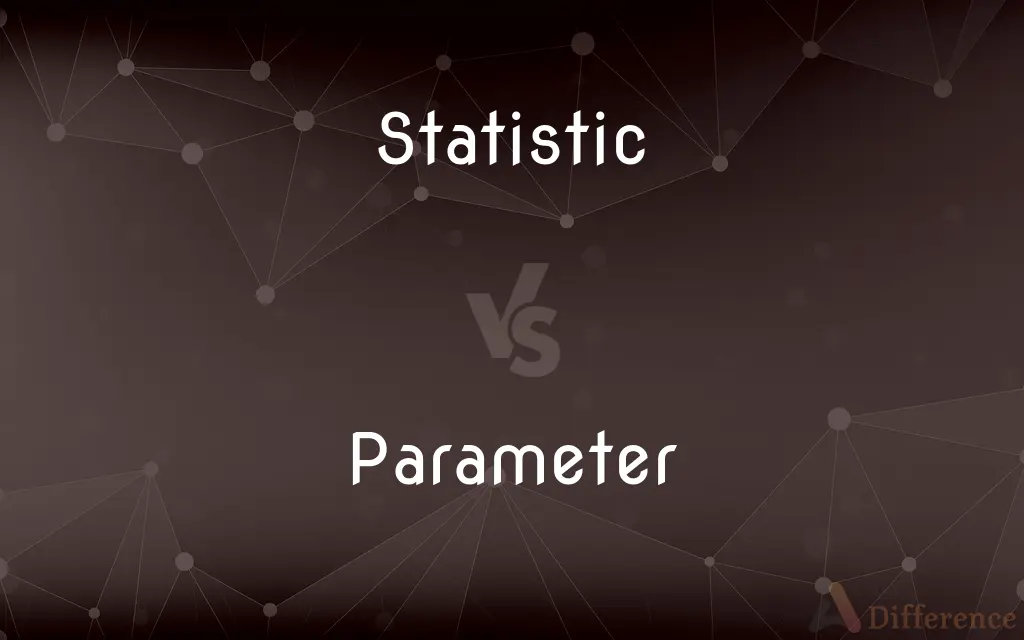Statistic vs. Parameter — What's the Difference?
Edited by Tayyaba Rehman — By Urooj Arif — Updated on April 18, 2024
A statistic is a measure derived from a sample of data, used to estimate the characteristics of a population, while a parameter is a measure that describes a characteristic of an entire population.

Difference Between Statistic and Parameter
Table of Contents
ADVERTISEMENT
Key Differences
A statistic is calculated from sample data, which is a subset of the population, making it a representative but imperfect estimate of the true state of the whole population. On the other hand, a parameter is derived from the full set of data in a population, providing an exact measurement of that population.
Statisticians use statistics to make inferences or hypotheses about a population due to practical constraints on data collection, whereas parameters, being measures of the whole population, are often theoretical ideals in many real-world applications because gathering complete data is usually impractical or impossible.
Statistics are subject to sampling variability; they can change from sample to sample, reflecting the random nature of sample selection. In contrast, parameters are fixed values, theoretically unchanging as they describe the entire population.
Examples of statistics include sample mean, sample variance, and sample standard deviation, which provide insights based on a selected portion of the population. Conversely, parameters include population mean, population variance, and population standard deviation, which describe broader, entire population characteristics.
In terms of application, statistics are critical in the field of inferential statistics, used to estimate or test hypotheses about parameters. Parameters, however, are used in modeling and simulation to represent real-world phenomena accurately when full population data is known.
ADVERTISEMENT
Comparison Chart
Definition
Measure derived from a sample
Measure describing a full population
Source of Data
Subset of the population (sample)
Entire population
Variability
Varies with different samples
Fixed, does not vary
Purpose
Estimate characteristics of the population
Describe exact characteristics of the population
Examples
Sample mean, sample variance, sample standard deviation
Population mean, population variance, population standard deviation
Compare with Definitions
Statistic
A numerical value that describes a characteristic of a sample.
The mean score of our sample of students is a statistic.
Parameter
Used in defining the theoretical framework of statistical models.
Population parameters are used in probability distributions.
Statistic
Calculated from a subset of the population.
We derived the statistic from a randomly selected group of participants.
Parameter
Represents the true state of a population.
The true average height is a parameter, not directly observable in large populations.
Statistic
Varies from sample to sample.
Different samples provide slightly different statistics.
Parameter
A numerical value summarizing a characteristic for an entire population.
The population mean age is a parameter.
Statistic
Used in making inferences about a population.
Using the sample statistic, we can estimate the population mean.
Parameter
Fixed and does not vary unless the population itself changes.
The parameter remains constant across studies of the same population.
Statistic
Helps in hypothesis testing.
We use sample statistics to test hypotheses about population parameters.
Parameter
Often estimated via statistics due to practical constraints.
Since we cannot survey the entire population, we estimate the parameter using statistics.
Statistic
A statistic (singular) or sample statistic is any quantity computed from values in a sample which is considered for a statistical purpose. Statistical purposes include estimating a population parameter, describing a sample, or evaluating a hypothesis.
Parameter
A parameter (from the Ancient Greek παρά, para: "beside", "subsidiary"; and μέτρον, metron: "measure"), generally, is any characteristic that can help in defining or classifying a particular system (meaning an event, project, object, situation, etc.). That is, a parameter is an element of a system that is useful, or critical, when identifying the system, or when evaluating its performance, status, condition, etc.
Statistic
A fact or piece of data obtained from a study of a large quantity of numerical data
The statistics show that the crime rate has increased
Parameter
A numerical or other measurable factor forming one of a set that defines a system or sets the conditions of its operation
There are three parameters by which a speaker is able to modify the meaning of the utterance—pitch, volume, and tempo
Statistic
Another term for statistical
Parameter
A limit or boundary which defines the scope of a particular process or activity
The parameters within which the media work
Statistic
A numerical piece of information.
Parameter
A constant in an equation that varies in other equations of the same general form, especially such a constant in the equation of a curve or surface that can be varied to represent a family of curves or surfaces.
Statistic
A calculated numerical value (such as the sample mean) that characterizes some aspect of a sample set of data, and that is often meant to estimate the true value of a corresponding parameter (such as the population mean) in an underlying population.
Parameter
One of a set of independent variables that express the coordinates of a point.
Statistic
One viewed solely as a piece of statistical or numerical information
Got laid off and became another statistic in the slumping economy.
Parameter
One of a set of measurable factors, such as temperature and pressure, that define a system and determine its behavior and are varied in an experiment.
Statistic
Alternative form of statistical
Parameter
Usage Problem A factor that restricts what is possible or what results
"all the parameters of shelter—where people will live, what mode of housing they will choose, and how they will pay for it" (New York).
Statistic
A single item in a statistical study.
Parameter
A factor that determines a range of variations; a boundary
An experimental school that keeps expanding the parameters of its curriculum.
Statistic
A quantity calculated from the data in a sample, which characterises an important aspect in the sample (such as mean or standard deviation).
Parameter
(Statistics) A quantity, such as a mean, that is calculated from data and describes a population.
Statistic
A person, or personal event, reduced to being an item of statistical information.
By dying from an overdose, he became just another statistic.
Parameter
Usage Problem A distinguishing characteristic or feature.
Statistic
Of or pertaining to statistics; as, statistical knowledge; statistical tabulation.
Parameter
A value kept constant during an experiment, equation, calculation, or similar, but varied over other versions of the experiment, equation, calculation, etc.
Statistic
A datum that can be represented numerically
Parameter
(sciences) A variable that describes some system (material, object, event, etc.) or some aspect thereof.
Parameter
(statistics) Any measured quantity of a statistical population that summarises or describes an aspect of the population.
Parameter
(machine learning) A variable of a model that is trained by a machine learning algorithm.
Parameter
(programming) An input variable of a function definition, that gets an actual value (argument) at execution time.
Parameter
An actual value given to such a formal parameter.
Parameter
A characteristic or feature that distinguishes something from others.
Parameter
(geometry) In the ellipse and hyperbola, a third proportional to any diameter and its conjugate, or in the parabola, to any abscissa and the corresponding ordinate.
The parameter of the principal axis of a conic section is called the latus rectum.
Parameter
(crystallography) The ratio of the three crystallographic axes which determines the position of any plane.
Parameter
(crystallography) The fundamental axial ratio for a given species.
Parameter
A constant number which is part of a theory, function, or calculation, whose value is not determined by the form of the theory or equation itself, and may in some cases be arbitrary assigned.
Parameter
A term applied to some characteristic magnitude whose value, invariable as long as one and the same function, curve, surface, etc., is considered, serves to distinguish that function, curve, surface, etc., from others of the same kind or family.
Parameter
Any constant number which is required to calculate values of observed phenomena according to a theory, but the value of which must be determined by experiment, and cannot be calculated from the fundamental assumptions of the theory. In general, a theory which has a large number of parameters, though it may accurately predict experimental results, is considered as having less explanatory power and as being less esthetically pleasing than a theory with fewer parameters.
Parameter
The ratio of the three crystallographic axes which determines the position of any plane; also, the fundamental axial ratio for a given species.
Parameter
The limits, guidelines, or assumptions from within which an activity is carried out; as, new arrivals need to learn the parameters of the research in our department.
Parameter
A variable used in a calculation within a computer program which must be assigned a value before the calculation can be performed; as, let's plug in the parameters and see what the result is.
Parameter
A characteristic or element, especially one used as a criterion for evaluation or judgment; as, a useful parameter for determining efficiency.
Parameter
A constant in the equation of a curve that can be varied to yield a family of similar curves
Parameter
Any factor that defines a system and determines (or limits) its performance
Parameter
A quantity (such as the mean or variance) that characterizes a statistical population and that can be estimated by calculations from sample data
Common Curiosities
What is a statistic?
A measure derived from a subset of data (sample) to estimate characteristics of a larger population.
Can parameters be calculated directly?
Parameters can be calculated directly only when full population data is available, which is rare in large populations.
How do statistics and parameters differ?
Statistics vary with samples and are used for estimation; parameters are fixed values describing the whole population.
Is there a statistical method to improve the accuracy of statistics?
Increasing sample size and using better sampling methods can improve the accuracy of statistics in estimating parameters.
How accurate are statistics in representing parameters?
Statistics provide an estimate that can vary due to sample size and selection but are designed to be as representative as possible.
How do researchers decide between using statistics and parameters?
Researchers use statistics when full population data is unavailable and parameters when it is accessible.
What is a parameter?
A measure that describes the true characteristic of an entire population.
Why use statistics instead of parameters?
Gathering data from an entire population is often impractical, so statistics provide a feasible approximation.
What is an example of a statistic in a research study?
The average income of sampled households in a study is a statistic.
What is an example of a parameter in real-world data?
The actual average temperature of an area, if known from complete data, is a parameter.
Why is knowledge of parameters important?
Understanding parameters helps in making accurate predictions and decisions based on the true characteristics of a population.
What role do statistics play in hypothesis testing?
Statistics help in making inferences or testing hypotheses about population parameters.
What happens when you have a large sample size?
A larger sample size generally provides statistics that are better estimators of the population parameters.
Can statistics become parameters?
Statistics do not become parameters; they are estimates used to infer parameters.
How do errors in sample data affect statistics and parameters?
Errors in sample data can lead to inaccurate statistics, misleading about the true population parameters.
Share Your Discovery

Previous Comparison
Hairdresser vs. Coiffeur
Next Comparison
Click vs. PressAuthor Spotlight
Written by
Urooj ArifUrooj is a skilled content writer at Ask Difference, known for her exceptional ability to simplify complex topics into engaging and informative content. With a passion for research and a flair for clear, concise writing, she consistently delivers articles that resonate with our diverse audience.
Edited by
Tayyaba RehmanTayyaba Rehman is a distinguished writer, currently serving as a primary contributor to askdifference.com. As a researcher in semantics and etymology, Tayyaba's passion for the complexity of languages and their distinctions has found a perfect home on the platform. Tayyaba delves into the intricacies of language, distinguishing between commonly confused words and phrases, thereby providing clarity for readers worldwide.














































